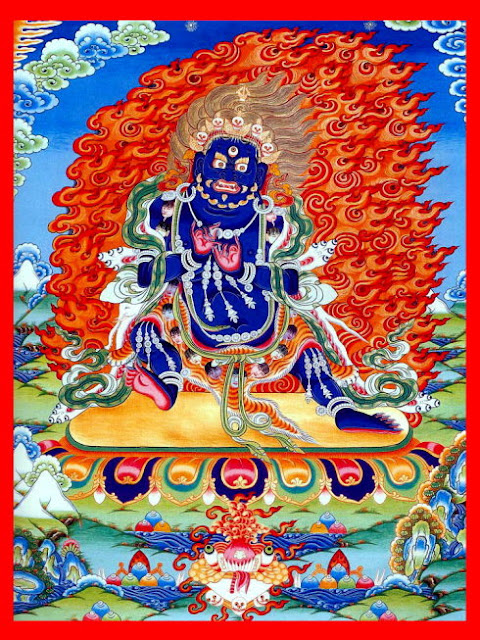A Wisdom King (Sanskrit: Vidyaraja, Chinese: 明王) is a type of wrathful deity. Whereas the Sanskrit name is translated literally as "wisdom / knowledge king(s)," the term vidyā in Vajrayana Buddhism is also specifically used to denote mantras and the term may thus also be rendered "mantra king(s).
A similar category of fierce deities known as Herukas are found in Tibetan Buddhism.The female counterparts of Wisdom Kings are known as Wisdom Queens (Sanskrit : Vidyarajni)
Vidyarajas, as their name suggests, are originally conceived of as the guardians and personifications of esoteric wisdom (vidyā), namely mantras and dharanis. They were seen as embodying the mystic power contained in these sacred utterances.
During the early stages of esoteric (Vajrayana) Buddhism, many of the deities that would become known as vidyarajas (a term that only came into use around the late 7th-early 8th century) were mainly seen as attendants of Bodhisattvas who were invoked for specific ends such as the removal of misfortune and obstacles to enlightenment.
*Krodharaja Achala (In Tibetan word: Tro Wo Gyal Po Me'o wa. In Japanese word: Fudo Myoo, or Fudo Myo-o. In English: The Immovable One, King of the Wrathful). Achala, also known as Krodha Chanda and Chanda Maharoshana, is a meditational deity in wrathful appearance. He is not a protector. There are however forms of Achala that are included in the Anuttarayoga groupings of the Ten Wrathful Ones.
Explanations and descriptions of these deities including Achala are found in the Tantras such as Guhyasamaja, Hevajra, Chakrasamvara, Vajrabhairava, etc. In the context of these Tantras, and the Twelve Wrathful Ones, Achala is a protector deity as part of a group of protectors within a larger system, or cycle, of practice.
Achala, blue, with one face and two hands. The right hand holds a sword raised to the sky. The left, a wrathful [gesture] together with a lasso, held in the heart. Having two red round eyes and pressing the lower lip with the upper teeth. Having a top-knot of black hair. Adorned with jewel ornaments and a white snake necklace. Having a lower garment of tiger skin. Kneeling with the left leg, and the right heel pressing on the seat in a manner of rising. Very wrathful, blue in colour, with one face, three eyes, brown hair flowing upward and two hands, he holds aloft the flaming sword of wisdom in the right hand. With the left placed at the heart in a wrathful gesture, he holds a Vajra lasso. Adorned with a crown of skulls and gold and jewel ornaments, earrings and necklaces he wears a scarf of green silk and a lower garment of tiger skin.
Kneeling with the left knee pressed down and the right raised, he dwells upon a sun and lotus seat as if about to stand, completely surrounded by the flames of pristine awareness atop a throne supported by the four worldly deities, Brahma, Vishnu, Indra and Shiva. The front is adorned with a sword motif. At the right and left sides are four Achalas, all in the same appearance save for the colours, red, yellow, green and white.
Krodharaja Achala is found in the Siddhaikavira Tantra, commonly known as the White Manjushri Tantra of the Kriya classification. It is from here that he takes on his role as a remover of obstacles and the special protector for the practices of Manjushri.
Krodharaja Achala is found in the Siddhaikavira Tantra, commonly known as the White Manjushri Tantra of the Kriya classification. It is from here that he takes on his role as a remover of obstacles and the special protector for the practices of Manjushri. In Anuttarayoga, Achala is also known as Candamaharoshana from the tantra of the same name, and has the same appearance with an added consort and nine-deity mandala.
The Kriya Tantra practice of Achala was popularized by Lord Atisha (982-1054), the founder of the Kadampa School and also by lobpon Sonam Tsemo of Sakya (1142-1182). The commentary is still in use today as the principal explanatory text. The practice of Achala in a standing posture was popularized by both Lord Atisha (982-1054) the founder of the Kadampa School followed by the Mitra Yogin (12th - 13th century) famous for the text known as the Mitra Gyatsa.
In the Kadam Tradition of Atisha, Achala is counted as one of the four principle deities (Kadam Lha Shi):
[1] Akshobhya
[2] Avalokiteshvara
[3] Tara
[4] Achala.
In this configuration of four, Achala has the same role as a meditational deity and remover of obstacles.
Fudo Myoo, or Fudo Myo-o, is the Japanese version of the Vajrayana Buddhist and East Asian Buddhist deity Acala or Acalanatha. In all its variants and all religions he exists in, Fudo Myoo is a wrathful deity and a protector of Dharma – a set of virtues and personal behaviors considered righteous in multiple Eastern religions, including Buddhism, Hinduism, Jainism, Sikhism, and others.
Most of all, however, Fudo Myoo’s (Achala Krodharao 不動明王) main goal is to literally frighten people into following the teachings of the Dainichi Buddha, also known as Vairocana or Maha Vairocana in Sanskrit. Dainichi Buddha is an old Indian Buddha that’s integral to Japanese Buddhism. Fudo Myoo is not the only “Myoo” who protects the faith in that Buddha.
Who are the Myō-ō Wisdom Kings in Japanese Buddhism? (Krodharaja Achala)
Fudo Myoo is one of the five Myō-ō of Japanese Buddhism. Also known as the Five Wisdom Kings, Mantra Kings, Knowledge Kings, Kings of Light, Kings of Mystical Knowledge, or just The Vidyaraja in Sanskrit, these five deities include:
- Gōzanze Myoo – King of the East
- Gundari Myoo – King of the South
- Daiitoku Myoo – King of the West
- Kongōyasha Myoo – King of the North
- Fudo Myoo – King of the Center.
(Not to be confused with the Four Heavenly Kings who include Bishamonten/Vaisravana).
* Footnote
For those who had received the empowerment of this Tantric practice, you are reminded not intentionally or unintentionally to disclose the mantra to the public or anyone who may not have the empowerment or permission to practice, and by disclosing the mantra intentionally or unintentionally is a form of breaking your Tantric Samaya vows to the lineage masters and Dharma protectors.
Please consult your Guru or a qualified lineage master for Vajrayana practice! Should a devotee even want to start studying and contemplating the Vajrayana practice, then it is truly necessary to first have completed the preliminaries and to be certain and sure that Bodhicitta has arisen and developed in one’s mind.
Vajrayana features countless skillful and powerful methods which, if they are practiced in the proper way, can make the process of accumulation and purification incredibly swift and direct. It is absolutely necessary to have the pure motivation and to know that Vajrayana practice is not carried out to increase one’s own ego, power and self-interests.

Donations for our Buddhist research and development
Do you earnestly cherish our devoted work? Assuming this is the case, we are delighted that you are finding our blog useful and valuable. Would you consider making a donation for our Buddhist research and development?
We need your help to secure the future of scholarly interaction with Buddhism. Since our very first publication of Dharma works and activities in the year 2008, we had been effortlessly providing free distribution of Dharma posts and articles throughout the previous 14 years. We have exceptionally constrained supports and do not receive subsidized or funding from people in general.
Please help us and to develop our Dharma activities that will not only benefit you, but to all Dharma readers on the planet. Please consider showing your support. Your generosity will certainly help us to enhance our work and to accomplish for a better and brighter prospect to come.
Thank you for reading, may you find peace and great bliss. With your support it helps to spread the Buddha’s precious teachings and turning the Dharma wheels in the world.
Aspiration For Bodhichitta
For those in whom the precious Bodhichitta has not arisen
May it arise and not decrease
But increase further and further.
Dedication of Merit
By this merit may we obtain omniscience then.
Having defeated the enemies wrong-doings.
May we liberate migratory from the ocean of existence.
With its stormy waves of birth, old age, sickness and death.
*Note
I do not own or infringe any copyright of the picture(s).
Picture(s) courtesy and credit to the rightful distributors and or studios.
Picture(s) is/are intended for editorial use only.











_1.jpg)

















.jpg)











